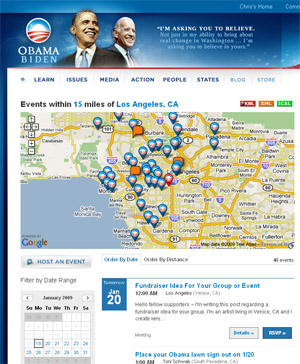What can we as planners learn from president-elect Barak Obama's use of technology? President-elect Obama has been an early adopter of Web 2.0 technologies both in his campaign and the transition to the White House. It is likely that the Obama administration will continue to use Web 2.0 technologies to both engage the public in determining policies and to make government operations more transparent. As planners, there are a lot of great tools and techniques that we can use in the planning processes. Here are some of the tools that the Obama team have used that could be used in planning.
What can we as planners learn from president-elect Barak Obama's use of technology?
President-elect Obama has been an early adopter of Web 2.0 technologies both in his campaign and the transition to the White House. It is likely that the Obama administration will continue to use Web 2.0 technologies to both engage the public in determining policies and to make government operations more transparent.
As planners, there are a lot of great tools and techniques that we can use in the planning processes. Here are some of the tools that the Obama team have used that could be used in planning.
 my.barackobama.com Website
my.barackobama.com Website
Many view the Obama campaign's use of the my.barackobama.com website and online organizing tools as a key to the campaign's success. Over 1 million registered users were able to setup their own blog, donate, send and receive emails and text messages, find or organize local events, and access a variety of resources to help mobilize voters.
Crowdsourcing
Some of the most interesting uses of Web 2.0 technology by the campaign have been in the arena of crowdsourcing -- the act of inviting a large number of people to help create, capture or analyze large amounts of data that is made possible through the use of collaborative technologies.
The Obama team invited visitors to recommend, discuss and vote on ideas for consideration by the Obama administration on the change.gov website. Over 125,000 users submitted over 44,000 ideas and cast over 1.4 million votes. The best rated ideas will be gathered into a Citizen's Briefing Book to be delivered to President Obama after he is sworn in.
Another example is the inauguration. CNN is inviting participants at the inauguration to help capture the moment when Barak Obama is sworn in by taking photos at that moment, and then sending them via SMS or email to CNN.
CNN will use Microsoft's Photosynth technology to create a 3D image of a moment in time using crowd-sourced images. Microsoft's Photosynth technology is a very exciting way to create three-dimensional environments from a collection of photos of a subject from different points of view.
YouTube
The days of five-second sound bites on the evening news are ending. Video sharing sites like YouTube give us access to the entire event or speech, not just the media-edited version. The Obama team has their own YouTube channel with over 1,800 videos from all aspects of the campaign, including speeches, events, ads, and documentaries. The campaign's use of YouTube was so successful that YouTube and Congress have now launched their own channels as well.
- Barack Obama's YouTube Channel
- The New York Times: YouTube Teams With Congress to Show Lawmakers at Work
Flickr
Many of us use this popular photosharing website for personal photos, but powerful organizing tools are also available. Obama's Flickr stream includes over 53,526 images submitted by supporters and the campaign.
Twitter
Twitter is a micro-blogging service, where users blog posts limited to 140 characters (a short sentence). Obama's twitter feed is followed by over 165,000 fellow twitterers.
Facebook
Nearly 4 million people have registered as Obama supporters on the popular social networking website, where the Obama team released regular updates during the campaign.

National Parks Layoffs Will Cause Communities to Lose Billions
Thousands of essential park workers were laid off this week, just before the busy spring break season.

Retro-silient?: America’s First “Eco-burb,” The Woodlands Turns 50
A master-planned community north of Houston offers lessons on green infrastructure and resilient design, but falls short of its founder’s lofty affordability and walkability goals.

Delivering for America Plan Will Downgrade Mail Service in at Least 49.5 Percent of Zip Codes
Republican and Democrat lawmakers criticize the plan for its disproportionate negative impact on rural communities.

Test News Post 1
This is a summary

Test News Headline 46
Test for the image on the front page.

Balancing Bombs and Butterflies: How the National Guard Protects a Rare Species
The National Guard at Fort Indiantown Gap uses GIS technology and land management strategies to balance military training with conservation efforts, ensuring the survival of the rare eastern regal fritillary butterfly.
Urban Design for Planners 1: Software Tools
This six-course series explores essential urban design concepts using open source software and equips planners with the tools they need to participate fully in the urban design process.
Planning for Universal Design
Learn the tools for implementing Universal Design in planning regulations.
EMC Planning Group, Inc.
Planetizen
Planetizen
Mpact (formerly Rail~Volution)
Great Falls Development Authority, Inc.
HUDs Office of Policy Development and Research
NYU Wagner Graduate School of Public Service


























